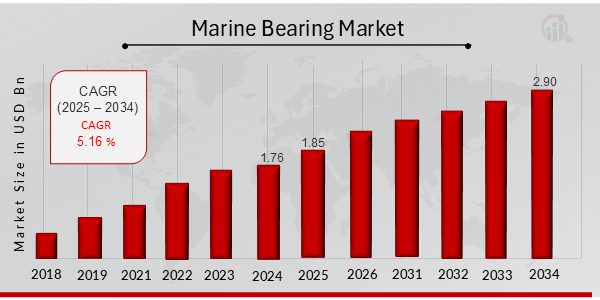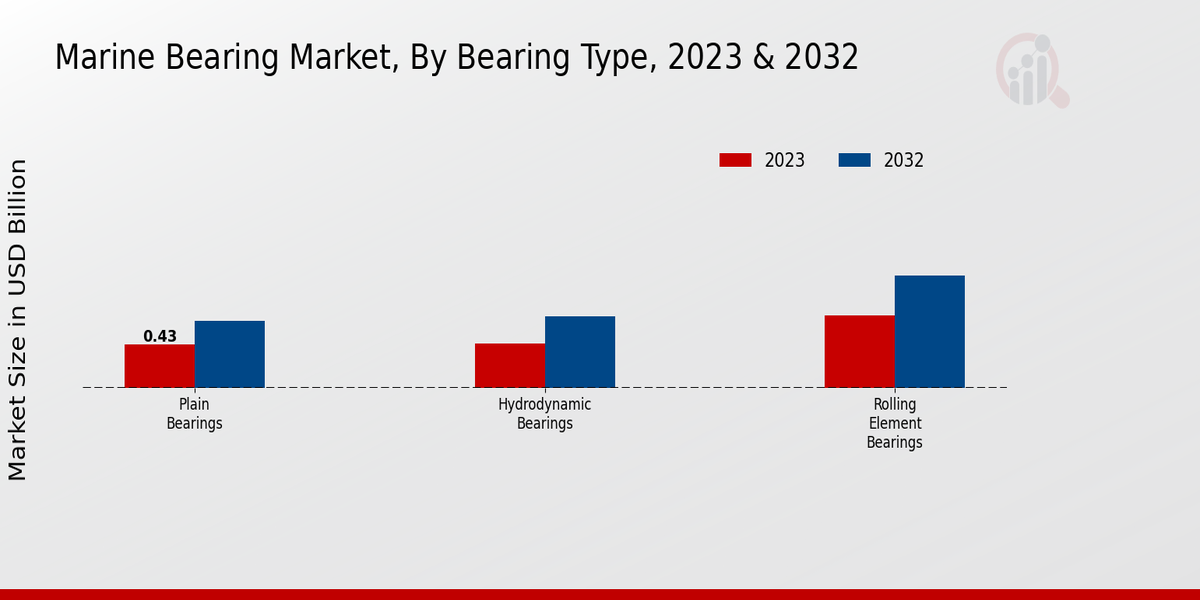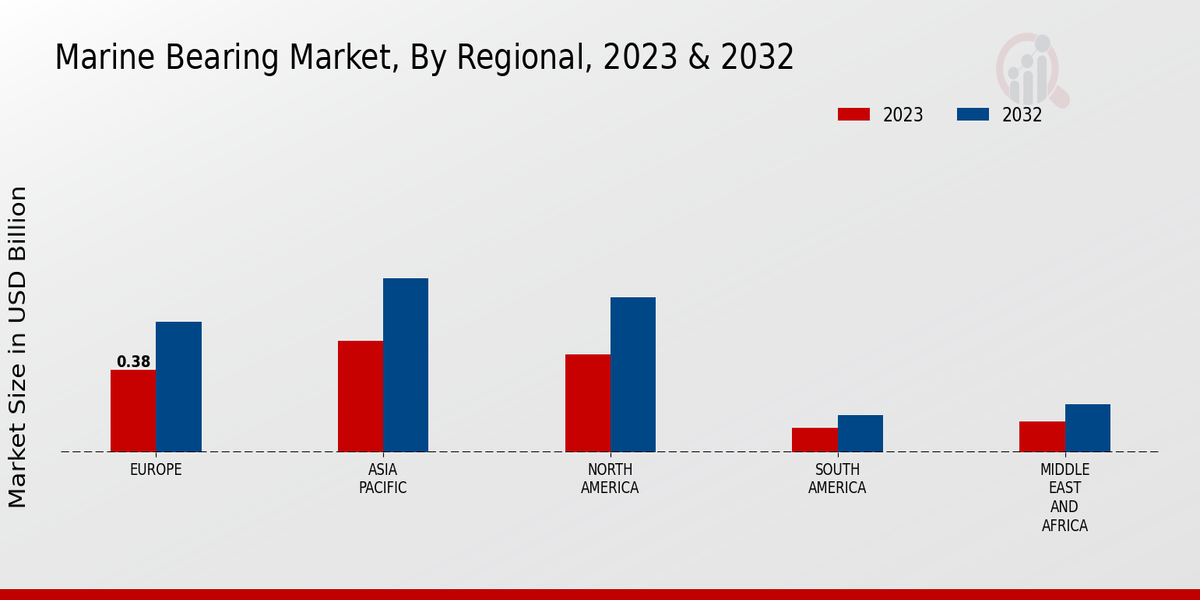Global Marine Bearing Market Overview
As per MRFR analysis, the Marine Bearing Market Size was estimated at 1.76 (USD Billion) in 2024. The Marine Bearing Market Industry is expected to grow from 1.85 (USD Billion) in 2025 to 2.90 (USD Billion) till 2034, at a CAGR (growth rate) is expected to be around 5.16% during the forecast period (2025 - 2034).
Key Marine Bearing Market Trends Highlighted
Key drivers influencing the marine bearing market include rising demand for commercial vessels, expanding offshore wind energy sector, and increasing adoption of eco-friendly bearings. The growing focus on fuel efficiency and environmental sustainability is driving the demand for bearings with reduced friction and low maintenance requirements.Opportunities for market growth lie in the expanding shipbuilding industry, particularly in developing economies. The increasing use of advanced materials, such as ceramic and composite bearings, presents potential for innovation and product differentiation.
The rising popularity of autonomous and electric vessels is expected to create new opportunities for bearings that cater to these specialized applications.Recent trends in the marine bearing market include the adoption of digitalization, data analytics, and condition monitoring systems to optimize bearing performance and reduce maintenance costs. The integration of IoT sensors and wireless communication enables real-time monitoring and predictive maintenance, reducing downtime and improving operational efficiency. The market is also witnessing a growing demand for corrosion-resistant and high-performance bearings for use in harsh marine environments.

Source: Primary Research, Secondary Research, MRFR Database and Analyst Review
Marine Bearing Market Drivers
Increasing Demand from the Offshore Wind Industry
The offshore wind industry is experiencing substantial growth as countries worldwide transition to renewable energy sources. Marine bearings play a crucial role in the operation of offshore wind turbines, which are subjected to harsh marine environments. These bearings enable the smooth rotation of the turbine components, ensuring efficient and reliable power generation. The expanding offshore wind market is anticipated to drive the demand for marine bearings, contributing to the growth of the Marine Bearing Market Industry.
Technological Advancements in Marine Transportation
The industry of marine transportation is constantly developing, and modern technologies help to introduce new approaches to its optimizing and maintenance. In order to guarantee the work of ship propulsion and the effective operation of engines and propellers, marine bearings are used. In the future, the progress of marine transportation, such as the appearance of more fuel-effective ships or autonomous shipping, will result in an increasing demand for high-performance marine bearings.
Growing Focus on Marine Infrastructure Development
Governments and private organizations are investing in the development and expansion of marine infrastructure, including ports, harbors, and offshore facilities. Marine bearings are utilized in various marine infrastructure applications, such as dockside equipment, cranes, and mooring systems. As marine infrastructure development continues to gain traction, it will drive the demand for marine bearings, supporting the growth of the Marine Bearing Market Industry.
Marine Bearing Market Segment Insights
Marine Bearing Market Bearing Type Insights
The Marine Bearing Market, segmented by Bearing Type, is experiencing notable shifts in dynamics, with its revenue estimated at 1.59 USD Billion in 2023 and projected to reach 2.5 USD Billion by 2032. Within this framework, Rolling Element Bearings hold a dominant position, generating a valuation of 0.72 USD Billion in 2023, which is forecasted to grow to 1.12 USD Billion in 2032. This segment's significance is underscored by its widespread application across various marine vessels, making it an essential component in ensuring reliability and efficiency in performance.
Moreover, Plain Bearings represent a critical segment as well, valued at 0.43 USD Billion in 2023, with expectations to rise to 0.67 USD Billion by 2032. Their simplicity and durability make them favorable for straightforward marine applications, contributing to their ongoing relevance in the market. Lastly, Hydrodynamic Bearings, valued at 0.44 USD Billion in 2023 and projected to reach 0.71 USD Billion by 2032, also play a vital role by providing effective fluid lubrication for enhanced performance in demanding environments.
The trend towards increasing efficiency in marine operations, driven by technological advancements and environmental considerations, along with the demand for enhanced durability and lower maintenance, is shaping the Marine Bearing Market.
As such, understanding the segmentation of the Marine Bearing Market facilitates insights into the evolving patterns and preferences driving market growth. The data regarding this market sheds light on potential opportunities, enabling stakeholders to strategize effectively in a competitive landscape characterized by challenges such as fluctuations in raw material prices and the need for innovation to meet stricter regulatory standards. As the market continues to evolve, the valuations across different Bearing Type segments highlight the interplay of demand and technological progress, positioning the market for continued development and adaptation in alignment with global marine industry needs.

Source: Primary Research, Secondary Research, MRFR Database and Analyst Review
Marine Bearing Market Material Insights
This segment primarily focuses on various materials used in the manufacturing of marine bearings, including Steel, Bronze, Polymer and Ceramic. The material chosen plays a crucial role due to its impact on durability, resistance to corrosion and overall performance in marine environments. Steel is often preferred for its strength and ability to withstand harsh conditions, while Bronze offers excellent wear resistance and longevity, making it a favorite in many applications.Polymer materials are gaining traction thanks to their lightweight properties and corrosion resistance, increasing their popularity among marine engineers.
Ceramic materials are valued for their exceptional performance under extreme temperatures and low friction, supporting innovative designs. As the Marine Bearing Market continues to expand, innovations in material science and increasing demand for efficient, durable components will drive growth in this segment, presenting numerous opportunities for manufacturers. The expected growth rate reflects the rising interest in enhancing operational performance and reducing maintenance costs across marine applications.
Marine Bearing Market Size Insights
The market consists of various segments, including small, medium, and large bearings. The small segment, comprising bearings below 100 mm in diameter, holds major importance due to its applications in smaller vessels and specific marine machinery, which demand precise engineering and lightweight components. The medium segment (100 to 500 mm) also plays a significant role as it caters to a broader range of maritime applications, including commercial shipping and recreational boats, thus contributing notably to the overall market dynamics.
Meanwhile, the large segment, encompassing bearings above 500 mm in diameter, dominates in terms of application in larger vessels and specialized marine equipment, often experiencing increased demand due to the requirements of heavy-duty operations. The growth of the Marine Bearing Market is also influenced by factors such as increased sea trade activities, advancements in marine technology, and a rise in vessel manufacturing, all contributing to the overall market growth and shaping the landscape for future developments.
Marine Bearing Market Application Insights
The Application segment of the Marine Bearing Market has been experiencing steady growth, with expectations to reach significant valuation figures in the coming years. Propulsion systems play a critical role, as they are essential for vessel movement, which influences the demand for marine bearings. Steering systems are also vital, directly impacting the navigability and control of marine vessels. Deck machinery demands robust and reliable bearings, as they are crucial for operational efficiency on the deck, handling various tasks in cargo loading and unloading.
Furthermore, auxiliary equipment, which supports the primary functionalities of marine vessels, presents significant opportunities due to the continuous advancements and innovations in marine technology. The growth drivers for this segment include increasing shipping activities, the need for efficient vessel operations, and advancements in bearing materials technology. Challenges, however, arise from stringent regulations and the need for regular maintenance. The Marine Bearing Market data suggests that ongoing trends towards automation and sustainability will further shape the applications of marine bearings in the industry.
Marine Bearing Market Regional Insights
The Marine Bearing Market has been experiencing notable growth across various regions. In 2023, North America held a significant valuation of 0.45 USD Billion, which is projected to increase to 0.71 USD Billion by 2032, indicating its dominance in the market. Europe, with a valuation of 0.38 USD Billion in 2023, is also poised to grow to 0.6 USD Billion by 2032, showcasing the region's strategic role.
Meanwhile, the Asia Pacific region, valued at 0.51 USD Billion in 2023, is expected to reach 0.8 USD Billion by 2032. This region plays a crucial role due to its expanding maritime activities and manufacturing capabilities.South America and the Middle East and Africa, while smaller markets are growing steadily, with valuations of 0.11 USD Billion and 0.14 USD Billion in 2023, projected to reach 0.17 USD Billion and 0.22 USD Billion, respectively, by 2032. The diversified growth in these regions reflects their increasing demand for marine applications and infrastructure development, highlighting opportunities for industry expansion and innovation within the Marine Bearing Market industry. Market growth in these areas may be driven by rising maritime trade, investments in shipping infrastructure, and an increasing focus on sustainable technologies.

Source: Primary Research, Secondary Research, MRFR Database and Analyst Review
Marine Bearing Market Key Players And Competitive Insights
Major players in Marine Bearing Market industry are focusing on developing innovative and advanced products to meet the growing demand for high-performance bearings in the marine sector. Leading Marine Bearing Market players are also investing in research and development to enhance the efficiency and durability of their products. The Marine Bearing Market is characterized by intense competition, with several established and emerging players vying for market share. Key players are adopting various strategies, such as mergers and acquisitions, to expand their product portfolio and geographical reach.
Additionally, companies are focusing on providing customized solutions to meet the specific requirements of their customers.SKF, a leading player in the Marine Bearing Market, offers a wide range of bearings designed specifically for marine applications. The company's products are known for their high quality, reliability, and durability. SKF has a strong global presence and a well-established distribution network, which enables it to reach customers in various parts of the world. The company is committed to providing innovative solutions and technical support to its customers in the marine industry.NSK, a competitor in the Marine Bearing Market, is another major player with a significant market share. The company specializes in the production of high-precision bearings for various industries, including the marine sector. NSK's bearings are known for their precision, low friction, and extended service life. The company has a global presence and a strong customer base in the marine industry. NSK is focused on developing new technologies and products to meet the evolving needs of its customers.
Key Companies in the Marine Bearing Market Include
- Dana Brevini
- Daito Seiko
- ThyssenKrupp Rothe Erde
- TriboTech
- JTEKT
- NTN
- NSK Ltd.
- Timken
- Schaeffler
- SKF
- RKB Bearing Manufacturing Co. Ltd.
- Bekaert
- Kaydon Corporation
- LYC Bearing Corporation
- FAG Bearings
Marine Bearing Market Industry Developments
The Marine Bearing Market is poised to expand at a steady CAGR of 5.16% during 2024-2032, reaching a value of USD 2.5 billion by 2032. Growing demand for marine vessels in various industries, including shipping, offshore oil and gas, and naval defense, is propelling market growth. Advancements in bearing technology, such as the development of self-lubricating and corrosion-resistant bearings, are further driving adoption. Increasing investments in renewable energy sources, particularly offshore wind farms, are presenting new opportunities for marine-bearing manufacturers. Key players are focusing on strategic partnerships and acquisitions to expand their global reach and product offerings. Regional markets, such as Asia-Pacific and Europe, are expected to witness significant growth due to rising shipbuilding activities and government initiatives to modernize naval fleets.
Marine Bearing Market Segmentation Insights
Marine Bearing Market Bearing Type Outlook
-
- Rolling Element Bearings
- Plain Bearings
- Hydrodynamic Bearings
Marine Bearing Market Material Outlook
-
- Steel
- Bronze
- Polymer
- Ceramic
Marine Bearing Market Size Outlook
-
- Small (below 100 mm diameter)
- Medium (100 to 500 mm diameter)
- Large (above 500 mm diameter)
Marine Bearing Market Application Outlook
-
- Propulsion Systems
- Steering Systems
- Deck Machinery
- Auxiliary Equipment
Marine Bearing Market Regional Outlook
-
-
North America
-
Europe
-
South America
-
Asia Pacific
-
Middle East and Africa
| Report Attribute/Metric |
Details |
|
Market Size 2024
|
1.76 (USD Billion)
|
|
Market Size 2025
|
1.85 (USD Billion)
|
|
Market Size 2034
|
2.90 (USD Billion)
|
|
Compound Annual Growth Rate (CAGR)
|
5.16% (2025 - 2034)
|
|
Report Coverage
|
Revenue Forecast, Competitive Landscape, Growth Factors, and Trends
|
|
Base Year
|
2024
|
|
Market Forecast Period
|
2025 - 2034
|
|
Historical Data
|
2019 - 2023
|
| Market Forecast Units |
USD Billion |
| Key Companies Profiled |
Dana Brevini, Daito Seiko, ThyssenKrupp Rothe Erde, TriboTech, JTEKT, NTN, NSK Ltd., Timken, Schaeffler, SKF, RKB Bearing Manufacturing Co. Ltd., Bekaert, Kaydon Corporation, LYC Bearing Corporation, FAG Bearings |
| Segments Covered |
Bearing Type, Material, Size, Application, Regional |
| Key Market Opportunities |
1. Growth in the shipbuilding industry 2. Increasing demand for offshore wind turbines 3. Growing adoption of electric propulsion systems 4. Development of new bearing materials and technologies 5. Emphasis on sustainability and environmental protection |
| Key Market Dynamics |
1. Increasing demand for marine vessels 2. Growing shipbuilding industry 3. Technological advancements 4. Stringent environmental regulations 5. Rising offshore energy exploration |
| Countries Covered |
North America, Europe, APAC, South America, MEA |
Frequently Asked Questions (FAQ) :
The Marine Bearing Market is expected to be valued at 2.90 USD Billion in 2034.
In 2024, the Marine Bearing Market was valued at 1.76 USD Billion.
The expected CAGR for the Marine Bearing Market from 2025 to 2034 is 5.16%.
North America holds the largest market share, valued at 0.45 USD Billion in 2023.
The market size for Rolling Element Bearings is projected to reach 1.12 USD Billion in 2032.
Key players in the market include Dana Brevini, ThyssenKrupp Rothe Erde, JTEKT, and SKF.
The market size for Hydrodynamic Bearings in 2023 is valued at 0.44 USD Billion.
The Marine Bearing Market in Europe is expected to grow to 0.6 USD Billion by 2032.
The growth drivers for the market include advancements in marine technologies and increasing maritime trade.
The market size for Plain Bearings is expected to reach 0.67 USD Billion in 2032.

















